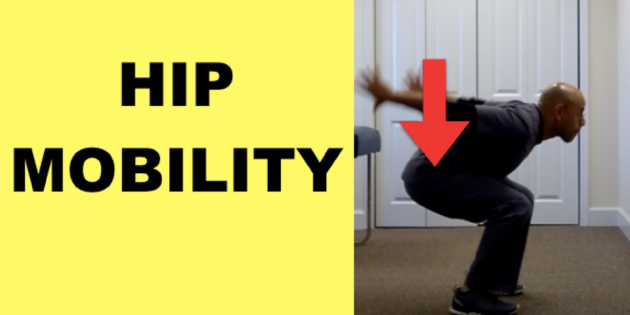If you’re dealing with knee pain and patellar tendonitis, it’s important to look at the biomechanics of the hip to make sure you’re moving properly.
A decrease in hip mobility can overload the quadriceps muscles and place more tension on the patellar tendon.
If your body lacks mobility in one joint, it will look above and below that joint to compensate for the lack of movement. In the case of the hip, your body will look at the lower back or the knees for compensation. So a lack of hip mobility can cause low back pain and knee pain.
Good hip mobility, on the other hand, will allow you to squat down low using your strong posterior chain muscles (glutes and hamstrings) instead of placing the load on the low back or the knees.
Having a lack of hip mobility will also prevent you from fully strengthening the glutes and hamstrings because you can move and train those muscles through their complete range of motion.
With low hip mobility and a decrease in strength in the hamstrings and glutes, in activities such as jumping, the quads will have to take on the additional load and once again pull more than normal on the patellar tendon and contribute to patellar tendonitis.
Since a decrease in hip mobility prevents you from squatting down low, the quads will have to assist and will generate less power when you jump, but that’s not the only issue.
After you jump, you won’t be able to absorb the impact correctly while landing.
If you can’t push the hips back when landing (hip mobility), the impact will be absorbed by your knees and quads and over time that will contribute to patellar tendinopathy.
This is why it’s super important to look at the whole kinetic chain when treating patellar tendonitis and not just focus on the knee.
To treat patellar tendinitis correctly, you have to take into consideration other contributing factors above and below the knee joint.
Below the knee joint, you have to look at the arches on your feet, the mobility in your ankles, the flexibility in the calves.
Above the knee joint, you have to look at the flexibility in the hamstrings, the tightness in the quads, hip mobility, and weaknesses in the gluteus muscles.
Even the best knee brace or patellar tendonitis strap will not fix your patellar tendinitis.
If you need a brace or strap on a regular basis just to get by, you are better off getting to the underlying root of the problem.
This is why it’s important to incorporate a complete treatment plan that shows you the correct patellar tendonitis exercises and stretches if you want to heal your jumper’s knee and patellar tendon pain.








